This section of the website is essentially static, though I update it as needed. However, if you’re looking for more immediate, “breaking news” type content about severe weather as it impacts RV dwellers, you may want to visit my Facebook group, Severe Weather for Nomads. During significant regional severe weather events and widespread outbreaks, I am usually monitoring the situation and updating the Facebook group with changing conditions and anything that looks immediately dangerous. I’m not, however, a meteorologist or forecaster, so use the information at your own risk.

West Coast
 The West Coast—Washington, Oregon, California—tends to be pretty temperate or moderate in its climate. However, at certain times of year, it can play host to extreme weather such as the remnants of Pacific hurricanes or typhoons (same thing, but the names differ according to where they originate); thick layers of marine fog that can make driving very hazardous; wild, strong winds like the Santa Anas in the south; usually calm but rainy spells in the north; and other RV-unfriendly things such as earthquakes and wildfires.
The West Coast—Washington, Oregon, California—tends to be pretty temperate or moderate in its climate. However, at certain times of year, it can play host to extreme weather such as the remnants of Pacific hurricanes or typhoons (same thing, but the names differ according to where they originate); thick layers of marine fog that can make driving very hazardous; wild, strong winds like the Santa Anas in the south; usually calm but rainy spells in the north; and other RV-unfriendly things such as earthquakes and wildfires.
Before you head for any part of the West Coast, do a little research (Google is also your friend) about severe weather or other threats you may encounter, and prepare a plan for how you might deal with them. It’s even more true with RVing than with other things that failure to plan is planning to fail.
Southwest
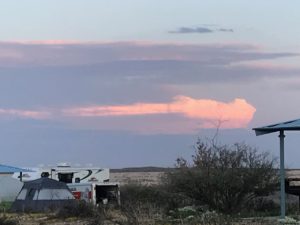 The desert Southwest—Nevada, Utah, Arizona, New Mexico, southern Colorado and East Texas—tends to be hot and dry during the day, and cool or cold and dry at night, depending on the season. It can experience snow, but usually in small amounts that disappear almost as soon as it falls. And the Southwest is frequently windy, sometimes to a point where it will mangle or tear off RV awnings left out carelessly. But there is a rather unique severe weather characteristic to this country: The seasonal monsoon.
The desert Southwest—Nevada, Utah, Arizona, New Mexico, southern Colorado and East Texas—tends to be hot and dry during the day, and cool or cold and dry at night, depending on the season. It can experience snow, but usually in small amounts that disappear almost as soon as it falls. And the Southwest is frequently windy, sometimes to a point where it will mangle or tear off RV awnings left out carelessly. But there is a rather unique severe weather characteristic to this country: The seasonal monsoon.
Though much milder than the monsoons that hit tropical areas of the world, this one is a pattern of pronounced increase in thunderstorms and rainfall over large areas, including northwestern Mexico, typically occurring between July and mid-September. During the monsoon, thunderstorms are fueled by daytime (diurnal) heating. These build up during the day, until they explode in late afternoon to early evening. Typically, these storms dissipate by late night. The next day starts out fair, with the cycle repeating daily.
The Plains
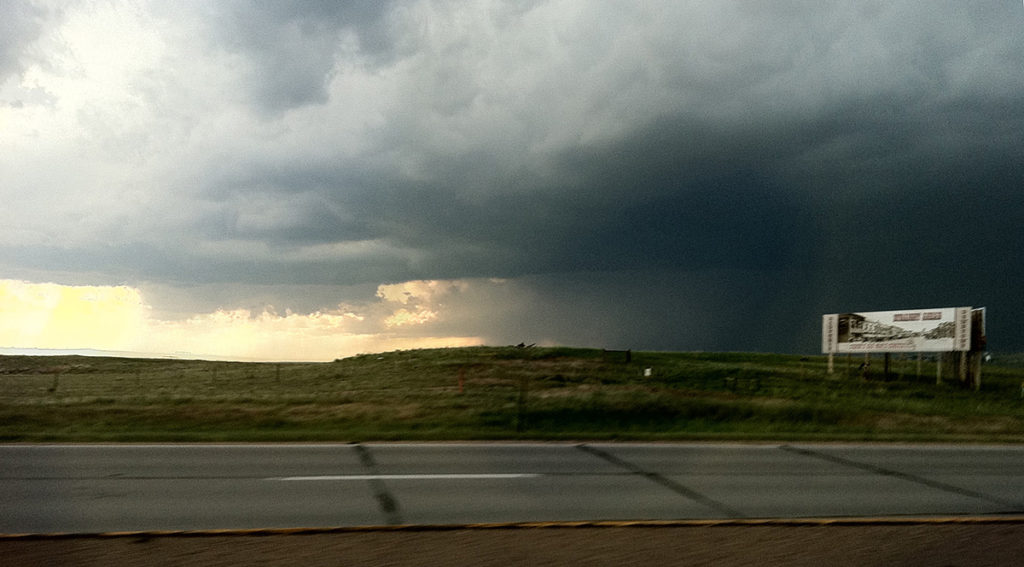
The Great Plains and High Plains of the continental U.S. are home to the greatest average number of tornadoes annually, anywhere in the world. This has led to the area’s nickname, Tornado Alley. Primarily, this area covers the core states of Nebraska, Kansas, eastern Colorado, extreme eastern New Mexico, western Oklahoma, the Texas Panhandle and north central Texas. However, this severe weather region can also include Idaho, Montana, southeastern Wyoming, the Dakotas, southern Minnesota, Iowa, Missouri and Arkansas.
The Tornado Alley phenomenon occurs because each spring, from about the middle of April through the middle of June, westerly winds sweep cool, dry air down off the Front Range of the Rocky Mountains and across the Plains. There, they collide with a pool of hot, humid air streaming up from the Gulf of Mexico. Whenever this phenomenon occurs, storms of the severe variety are almost certain to happen.
Of course, not all storms capable of breeding tornadoes actually do, so many of these end up staying at the level of severe thunderstorm,. This may occasionally include hail, which can be large enough to damage a vehicle, and kill animals and people.
RVers must be concerned about hail, as it can severely damage motorhomes and travel trailers, as well as tow vehicles. If you’re on the road when a hailstorm occurs, you need to get underneath sheltering structures as much as possible. Admittedly, this can be difficult for those hauling fifth wheels and other ultra-high profile vehicles.
Look for an overpass, pull as far off the road as possible, and stop beneath it until the storm passes. CAUTION: Be very careful to pull completely out of active traffic lanes. If an overpass isn’t available, a large tree may offer some protection, as its leaves and branches will take the brunt of the punishment from solid ice balls hurtling toward Earth. A service station canopy will also offer some protection. Smaller rigs can shelter beneath hotel covered parking or even bank drive-throughs.
In winter, the High Plains states can be pounded by snowstorms and blizzards that make travel extremely dangerous if not impossible, especially in high profile vehicles like most RVs. Wind is a huge safety factor, and at higher elevations, roadways can become impassable without safety chains. It’s best to follow the example of the smarter pioneers, and avoid these areas altogether in snow season.
Midwest
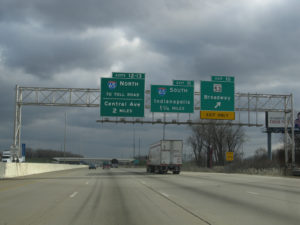 The secondary states listed above, along with Wisconsin, Illinois, Michigan, Indiana and Ohio are prone to severe thunderstorms and tornadoes in any season but winter. Winter gives them snowstorms and blizzards, which have become more frequent and intense with the onset of recent climate change.
The secondary states listed above, along with Wisconsin, Illinois, Michigan, Indiana and Ohio are prone to severe thunderstorms and tornadoes in any season but winter. Winter gives them snowstorms and blizzards, which have become more frequent and intense with the onset of recent climate change.
The real danger here is that so much of the Midwest is very flat, open land that offers little shelter to a rig on the road. There are long stretches of Interstate between exits in prime tornado country. This is good for being able to see storms approaching, but not so great if you need to shelter in a hurry. So it’s very important to know, before starting a travel day in the Midwest, what’s ahead weather-wise. This is where using the better forecasting apps can really help you stay safe and on the road.
Please remember that while overpasses are good shelters from hail, they are actually dangerous places to try to shelter from tornadoes. This is because they form artificial wind tunnels that actually speed up the already insanely fast winds. Despite the famous TV reporter footage showing people surviving a direct hit from a tornado under an overpass, that was because the tornado was relatively weak—an EF0-EF2. Stronger storms would have torn them right out of there.
New England
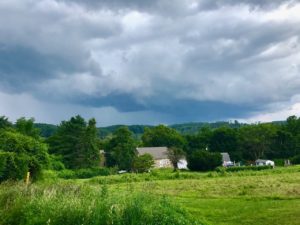 The Northeast states of Maine, New Hampshire, Vermont, New York, Connecticut, Massachusetts, and Rhode Island have been experiencing more severe thunderstorms and tornadoes in recent years. However, their prime weather threat to RVers is heavy snow in winter and heavy marine layer fog in the other seasons.
The Northeast states of Maine, New Hampshire, Vermont, New York, Connecticut, Massachusetts, and Rhode Island have been experiencing more severe thunderstorms and tornadoes in recent years. However, their prime weather threat to RVers is heavy snow in winter and heavy marine layer fog in the other seasons.
The heavily forested regions are also vulnerable to wildfires in dry years. Infrequently, coastal regions can be hit by the remnants of tropical systems with high winds, and inland areas can catch intense rain from these same events. Fortunately, these are covered by NOAA All-Hazards alerts on good weather radios.
MidAtlantic
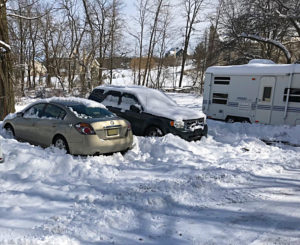
Pennsylvania, New Jersey, Delaware, Maryland and the Virginias make up the MidAtlantic region. Severe weather here includes the same threats as the New England area, plus a higher frequency of hurricanes and other tropical systems.
Like New England, the MidAtlantic also experiences its share of Nor’easter type storms, usually in the “shoulder” seasons of spring and fall. These storms are intense rain and wind events that can also include sleet and snow, whose winds come primarily from the east instead of the usual prevailing westerlies. These storms can reach hurricane wind strength and are often very destructive, especially in coastal regions. RVers would do well to steer clear of these storms, which can rock and even roll your rig, despite its being parked and stabilized.
Especially in the past decade or so, it is also not unheard of to experience mild to moderate earthquakes in the MidAtlantic. Several seismic faultlines run along the coast in this area, and fracking activities have been shown to trigger these tremors.
Southeast
 Central and southern Texas, Louisana, Tennessee, Mississippi, Alabama, Georgia, Florida and the Carolinas offer a triple threat to RVers when it comes to weather. Most common are intense heat waves during the summer months, when most RVers are on the road. These states, due to their proximity to the Atlantic and Gulf Coasts, are also primer landfall areas for hurricanes that form in the Atlantic basin, Caribbean Sea, and the Gulf.
Central and southern Texas, Louisana, Tennessee, Mississippi, Alabama, Georgia, Florida and the Carolinas offer a triple threat to RVers when it comes to weather. Most common are intense heat waves during the summer months, when most RVers are on the road. These states, due to their proximity to the Atlantic and Gulf Coasts, are also primer landfall areas for hurricanes that form in the Atlantic basin, Caribbean Sea, and the Gulf.
And, especially in the past 20 years or so, there is much evidence that climate change is shifting Tornado Alley eastward. Some of the very worst tornado outbreaks, including violent, intense (EF3 or stronger) and long-track twisters, have occurred here in recent years. So much so, in fact, that this area has now earned the moniker Dixie Alley.
Tornado season here actually precedes that of Tornado Alley, though there is some overlap. Dixie Alley can become active as early as January, though typically things ramp up to their most intense from about mid-February through the end of May. However, tornadoes can occur here any time of year, and smart RVers are never far from their weather radios when camped in the Southeast.
One other infrequent but significant weather phenomena here is ice storms. Ice storms occur most frequently in northern tier states, obviously. But people there are used to them, and municipalities are equipped to respond more quickly and effectively. In the South, however, even small accumulations of ice on trees and roadways can be crippling. In early spring and late fall, it’s best to stay aware of developing systems moving in from the west and north.
If you know an ice storm is headed your way, your safest move is to get out of its way. However, since most of these systems originate in areas to which we would typically escape, sometimes the only recourse is to hunker down and hope for the best. One place you do NOT want to park your rig during an ice storm is beneath anything—trees or manmade structures—that might accumulate ice and either drop that ice on top of you as it slides off, or drop entire pieces of itself, such as branches, as the ice becomes too heavy to support.
You don’t have to be on the road to die in an ice storm. If you’re worried about things dropping on your rig but you can’t move, get a hotel room until the worst has passed. Part of that planning may include finding places that accept pets, so stay out in front of this situation.
More:
- RV Weather – Main Page
- RV Weather – Recognizing Severe Weather Conditions
- RV Weather – Weather Awareness and What To Do
- RV Weather – How Severe Weather Develops
- RV Weather – How Storms Turn Violent
- RV Weather – Types of Clouds to Watch For
- RV Weather – Hurricanes and Tropical Systems
- RV Weather – Snowstorms, Blizzards and Other Winter Stuff
- RV Weather – Smartphone Apps
- Current Severe Weather Alerts for Nomads – My Facebook Group
